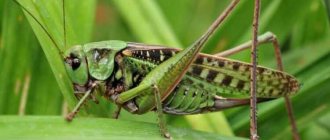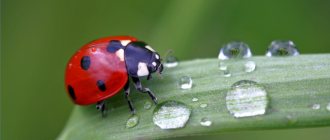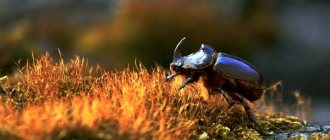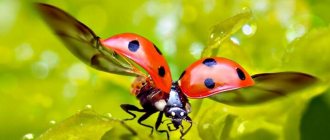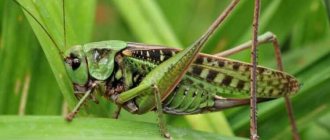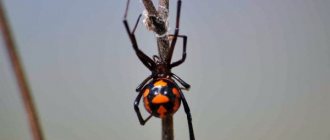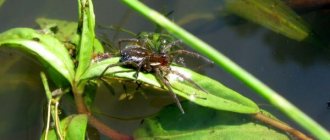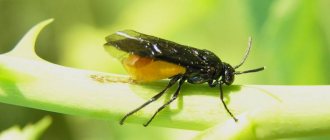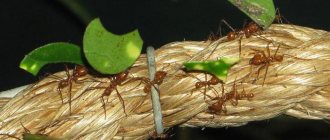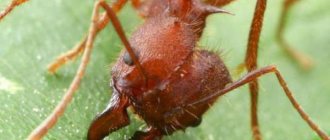The blue-winged filly lives in arid steppe regions. A characteristic feature of the species is the adaptation of body color to the color of the soil. Even at the larval stage, insects adapt to their environment. The body of fillies is stocky, females are much larger than males. This species is not prone to flying. Adults live in isolation, without leaving their usual habitats. Changes in natural conditions and recreational development of areas lead to the death of insects. The species is listed in the Red Book of the Moscow and Tula regions.
Peculiarities of locust reproduction and different options for existence
The population of female locusts exceeds the population of males by about 5 times.
This contributes to the unification of several females around one male. 7 days after molting, the male enters the active mating phase, which he immediately informs the females about. The male rubs his elytra with his hind legs. Females hear a characteristic creak and fly towards the sound. After which the male sits on the female and grabs special grooves on her cephalothorax. The last segment of the male individual crawls under the last segment of the female and mating occurs.
At the end of summer and throughout the fall, female locusts lay eggs. With her last segment, the female makes a hole in the ground for laying eggs. After this, she releases a foam-like secretion containing eggs from the ovipositor. The secretion is secreted by a certain gland and serves to protect the masonry. The female lays about a hundred eggs in one hole. After several clutches the female dies. In one square meter, female locusts can make up to 2000 clutches.
In a warm climate zone, the female lays eggs up to 6-8 times, all year round.
And in colder latitudes with significant temperature changes, locust offspring hatch with the onset of spring, having survived low temperatures in the soil.
The offspring of locusts are tiny white larvae with underdeveloped wings. But within a couple of hours, the larva will change its color and begin to eat vegetation. The larva reaches the adult stage of development (imago) in about a month, after four molts.
The variants of locust development that differ from one another—individual and collective—have certain characteristics. The solitary locust (filly) and the gregarious locust differ in appearance and behavior.
Thus, the filly has a protective color; unlike the herd representative of the species, it leads a rather passive life. She has a poorly developed ability to fly.
The body color of the herd pest is bright in color. The gregarious locust is active, gathering in groups of adults (imago) and groups of larvae (bands). In gregarious locusts there are no differences in size between females and males.
This insect remains solitary until there is enough food. As soon as there is a nutritional deficiency, a period of drought and/or the population of fillies exceeds a critical number, the locusts rebuild. As a result, insects lay locust larvae in the ground, which are prone to gregarious behavior. Such offspring are distinguished by larger body and wing sizes and a tendency to gather in large flocks.
This assumption was proven experimentally. Thus, mirrors were placed in the territory where the resident locusts lived. As a result, the locusts began to come into conflict with their own reflection in the mirror. This caused the locusts to lay down a generation prone to gregariousness.
According to the latest data, a lack of protein compounds leads to the transformation of a single locust into an individual prone to being in a swarm. At the same time, locusts are divided into two camps: aggressors who eat representatives of their own species, and victims who flee so as not to be eaten by their relatives.
Along the way, both camps eat all the vegetation they encounter along the way. It turns out that a sufficient amount of food contributes to the preservation of the solitary phase. Food deficiency, on the contrary, triggers a regime in insects that leads to the laying of offspring.
The presence of locusts in a group of their own kind leads to the production of the hormone serotonin, which entails rapid metamorphoses in the structure of the locust. Physiological changes occur within a few hours. Thus, locusts change color, body size increases, but sexual dimorphism, on the contrary, disappears.
Locust larvae gather in swarms, while adult locusts gather in swarms. And this entire multimillion-dollar group, as a single organism, is moving in the same direction. Outwardly, the locusts from the herd become similar to one another. This large army stretches for tens of kilometers. And per day it covers from 90 to 140 km.
In this case, weakened insects are eaten by stronger ones. The number of swarms can reach several billion pests. Weight - up to several tens of tons.
The friction of hundreds of millions of pests against each other causes sounds that are impossible not to hear. An army of locusts, like a forest fire, destroys everything in its path, right down to the roofs of houses made of straw.
Any vegetation, be it a garden, a field, a vegetable garden, a vineyard, is completely destroyed. In the modern world, this pest causes great inconvenience to farmers and agricultural enterprises. Fifty years ago, the attack of this pest led to real famine.
Habitat
Locusts usually prefer to settle in the subtropical and tropical zones of Africa, Arabia, India and Pakistan, because their high vitality and ability to fly long distances allow them to easily survive in these arid areas and almost always find food for themselves.
The ability to overcome long distances has been scientifically proven, as desert locusts have been spotted even on the American continent, as well as in Iran and Afghanistan.
Desert locusts are distinguished by migrations of two species:
- seasonal - annual travel for the purpose of breeding from south to north Africa and back;
- invasive - one-time movement of huge flocks over many thousands of kilometers.
The wind helps the locusts on long flights, sometimes allowing them to rise in a frightening cloud up to two kilometers in height. The flock moves only during the day; at night the insects rest. During their flights, they look for wet places suitable for breeding, where they stop to mate and lay eggs. The hatched individuals, having grown a little, are already heading back to southern Africa.
Sound production organs in fillies
On a hot afternoon, loud chirping can be heard in the fields and meadows. Usually people smile when they hear these sounds and say: “That’s how the grasshoppers started chattering!” But this is a wrong judgment!
Grasshoppers by nature sit quietly during the day. Therefore it is impossible to hear them. Either locusts or grasshoppers chirp in broad daylight. Moreover, only males do this. In this “musical” way they attract females. There is a second explanation for the loud chirping of male fillies. With their sounds they warn other males that the given territory is already occupied.
The fillies produce their sounds by rubbing the tubercles located on the thighs of their hind legs against the vein under the elytra.
Why are insects dangerous to humans?
Having heard enough horror stories, many are interested in the answer to the question of what will happen if an earwig or two-tailed duck gets into your ear. It’s worth immediately debunking the myth that an insect will not gnaw through the eardrum. A person, and especially his ear, is of no interest to him at all. Neither the earwig nor the double-tailed parasite are blood-sucking parasites. They prefer to lay eggs in the surface layers of the soil, having first dug a tunnel and built a nest. Not a single case has been recorded of an earwig or double-tailed earwig laying eggs in the ear.
The chances of insects penetrating the human hearing organs are exactly the same as those of an ant or any other small representative of the fauna. The scenario is possible that, while relaxing in nature, a pickerel or forktail will accidentally crawl into the ear of a sleeping person, but it will not be able to climb beyond its limits. Therefore, the answer to the question whether a double-tail can get into the ear may be positive, but there is no particular reason to worry. According to statistics, cockroaches end up in the ear much more often than stingers. But if they appear in the house, it is advisable to get rid of earwigs.
Social structure and reproduction
Photo: Large locust
Locusts lay eggs and reproduce sexually. To attract a female, the male uses a specific hormone (produced by the male when he vibrates his wings), and the female, in turn, chooses the male based on the smell she likes. After she discovers a male, she tries to get as close to him as possible. The male lightly touches the partner a couple of times with his antennae, and after that he attaches himself to the female and tries to deposit a special capsule with sperm in the back of her abdomen.
This is a rather labor-intensive and time-consuming procedure, so the approximate mating time is 13 hours, but it can happen faster. After mating, the female buries the ovipositor in moist soil, covering it with a special foamed liquid, which, after hardening, turns into a hardened cocoon. The average number of eggs in one clutch ranges from 60 to 80 eggs. Throughout her life, the female makes from 6 to 12 clutches, which on average equals four hundred eggs. After twelve days, white larvae simultaneously emerge from the eggs, which after birth begin to actively eat and grow.
In order to get out of the capsule, the larvae require a lot of effort and time. As soon as the larvae hatch, they molt and release their limbs. The locust larva is very similar to the adult, it is only much smaller and lacks wings. After experiencing several stages of development, the larva becomes an adult locust after 35–40 days, undergoing five moults.
Nutrition
Those individuals that live separately are not known for their gluttony. Over the course of its entire life, one locust can consume up to 300 grams of plants. However, when she gets into a pack, her behavior changes dramatically.
A locust invasion causes enormous harm, since, having met its relatives, the insect becomes omnivorous and begins to absorb everything it sees: reeds, reeds, fruits, grain crops, and so on.
Long flights and lack of food force the locusts to feed on their weaker relatives.
Features of reproduction
Mating occurs a week after the females fledge. After 5-10 days they are ready to give birth. Siberian fillies choose dry areas with sparse vegetation for laying. The female lays eggs in a small hole, then fills it with a special liquid. After mixing with soil, a frozen mass is formed - a capsule. It contains whitish-gray eggs. There are 7-15 of them in a clutch. The length of the eggs is 4-5 mm, they are laid in 2-3 rows. The outlet is covered with an earthen cap. The free space is filled with fine-meshed secretion. Each female leaves 8-15 such egg capsules in the soil. The masonry is placed at a depth of 15-20 mm, but sometimes it is simply left on the surface. The breeding process lasts up to four weeks. Having completed their function of procreation, the females die. The egg stage is the longest period of locust life, it takes 7-9 months.
The larvae hatch early, in the southern regions in April, in the northern regions in May. This stage lasts about a month. The larvae go through 4 instars, their change is associated with molting. After shedding the old skin, the larvae almost double in size. They feed on succulent parts of plants or grains. Wild species are eaten completely.
Spreading
The habitat covers Siberia, Central and Southern Europe. The Siberian filly is also common in Central Asia, Mongolia, northern Kazakhstan and northeastern China.
The European population is limited to mountain ranges: the Pyrenees and Sierra de Guadarrama in the west, the Apennines, Alps, Balkans and Carpathians in the south. In most regions it is small in number and has not reproduced en masse in recent years.
The insect settles in the steppe and forest-steppe zones, preferring dry areas, rocky and well-lit areas. In the mountains it is found at altitudes up to 1200 m above sea level.
There are 8 known subspecies. The most numerous and widespread is the nominative subspecies Gs sibiricus.
Limiting factors and protection
Blue-winged fillies live in local populations, separated from each other. The number of species is negatively affected by:
- grass has fallen;
- any disturbance of the soil cover;
- grazing;
- chemical treatments of fields;
- overgrowing of areas with weeds and bushes, lack of open soil.
The species is included in the Red Book of Moscow and the Tula region. Restoration measures are being taken in remaining habitats.
Giant locust June 8th, 2013
This is some kind of passion! I generally don’t like all kinds of bugs - cockroaches, but here it is!
Giant Pipit Tropidacris collaris. One of the largest species of orthopteran insects .
Homeland - Trinidad. Natural distribution range extends throughout the northern part of South America, especially in the tropical regions of French Guiana and Suriname. Locusts live on the ground or among low bushes.
This cell phone is too small for me! - said the locust and turned away... / Giant pipit Tropidacris collaris, locust family, homeland - Trinidad (Central America) / exhibition of live insects at the biology department of Moscow State University
Tropidacriss stay alone near fruit trees, the leaves of which they feed on. Although they jump well, they prefer to sit, hiding, because birds, animals and even people are not averse to feasting on such large insects.
Females of the South American locust reach up to 9 cm in length, the wing length is 10 cm. The body weight of females is up to 30 g. The males are slightly smaller, about 70 cm in length, the wing length is 9 cm. This relatively sedentary insect does not form large flocks, but may harm tropical fruit trees, whose leaves it prefers to feed on. However, there are also many animals, birds and even people who want to feast on tasty insects, so the giant locust tries to move less, relying on its protective greenish-brown coloring. And its larvae, on the contrary, have a bright, warning color, consisting of alternating yellow, red and black stripes.
Locusts reach sexual maturity in approximately 5 weeks. To fertilize, the male jumps on the female, straddles her on top, holding her firmly with his front paws, bends his abdomen under her body and attaches himself to it with his genitals. It then deposits a spermatophore (a packet containing sperm) at the base of the female's ovipositor. Mating continues for several hours.
To lay eggs, the female makes holes in the soil using the ovipositor, and the abdomen, like a telescope, can extend three times. The channel in the soil is filled with a foamy secretion, into which the female lays 50-100 oval-shaped eggs. After hardening, the foam forms a cocoon, which provides protection for the eggs - both from enemies and from drying out. The larvae emerging from the eggs free themselves from the cocoon and crawl to the surface. The size of the larvae is about 6 mm, the color is white, the body is soft. After the cuticle hardens, the growth phase begins. The characteristic color appears after a few hours.
To transform into an adult insect (imago), the locust larva undergoes 5 molts. The larvae resemble adults in miniature, but they do not have real wings, but only their rudiments, which gradually develop as they molt. The lifespan of locusts is about 6 months.
The temperature is 25-28 °C, lighting is required. Air humidity 70-80%. Food – leaves of blackberry, raspberry, oak, beech, rhododendron.
These are very annoying creatures! When flying, they make a buzzing sound and when they land on your clothing, they cling to it so that it is impossible to tear them off. It is very unpleasant to be in their swarm. Locust swarms typically number in the billions, consuming millions of tons of crops along the way.
I already thought that this photo was photoshopped, but this 4.5 inch is a real passion!
Pest control
Agrotechnical measures
As a preventative measure against locusts (in those areas where there is a high probability of a massive invasion of harmful insects), it is necessary to carry out thorough and deep cultivation (ploughing) of the soil, which destroys capsules with eggs.
Chemical methods of control
Effective protection of plantings in the face of unprecedented gluttony and mass numbers of locusts is only possible with the use of chemical plant protection methods.
If there is a mass concentration of locust larvae in one area, use pesticides with a validity period of at least thirty days. To treat and kill insects, they use drugs such as “Karate”, “Confidor”, “Image”, but it is possible to effectively use poisons to combat the Colorado potato beetle.
A good result is shown by the systemic drug Clotiamet VDG, which provides reliable protection against locusts for three weeks. This poison is good because it can be effectively used in a tank mixture with other microfertilizers, protective agents and plant growth stimulants, but it is necessary to first test for compatibility with other chemicals.
Preparations such as “Gladiator” and “Damilin” effectively destroy locusts (both larvae and adult insects). The insecticide "Damilin" has a negative effect on the larvae, slowing down their development and disrupting the timing of the formation of the chitinous body shell, as a result of which the insects die. The big advantage of the drug is its low toxicity.
- The first chronicle mention of a locust invasion of Rus' dates back to 1008, which resulted in famine. The invasion was repeated in 1094, 1095, 1103 and 1195. Similar misfortunes were repeated in the 16th–17th centuries. In 1824, an invasion of locusts was observed in the south of modern Ukraine, in the Kherson, Yekaterinoslav and Tauride provinces, and A. S. Pushkin was sent to fight it. He wrote a short report:
- The largest locust invasion in human history occurred in the United States in 1875. A swarm of locusts from the state of Texas spread to the west, but after some time, having caused colossal devastation, disappeared as suddenly as it appeared.
- Currently, vast areas of crops across the Earth are suffering from locust infestations, especially in Africa.
- Locusts are found almost everywhere, except in the coldest areas.
- The body length of the locust ranges from 1 cm in the meadow locust to 6 cm in the migratory locust. The largest individuals can reach 20 cm in length.
- Locusts differ from grasshoppers and crickets in the length of their antennae: they are shorter.
- Every day, one individual locust eats an amount of plant food equal to its own weight.
- There are swarms of locusts numbering several billion individuals. They form “flying clouds” or “clouds”, the area of which can reach 1000 km 2.
- When the locust's wings rub against each other, a characteristic creaking sound is heard. The noise produced by a flock of several million insects in flight can be mistaken for thunder.
- Sound production in locusts is carried out by rubbing the hind leg with special tubercles on the elytra.
- Locusts live from 8 months to 2 years.
Chin hair removal for women
Many methods are available for women who want to remove chin hair. These include:
Electrolysis
is a hair removal method that uses electric current to destroy the hair follicles, preventing any hair from growing in the area. This procedure is usually performed by a dermatologist and may require multiple treatments. Electrolysis has a longer lasting effect than other hair removal methods.
Laser hair removal
- This is also a method of combating hair on the chin.
Photoepilation
- the name of laser hair removal. The procedure uses lasers to destroy hair follicles. However, this procedure may not be suitable for people with dark skin types as it causes complications that can affect skin pigmentation.
Plucking individual hairs with tweezers
temporarily deletes them. However, this procedure must be performed constantly.
Shaving can remove chin hair, but this can lead to irritation and pseudofollicles
that appear around the hair follicle.
Like plucking, shaving is a temporary method of hair removal.
Waxing
involves applying a special wax to the skin area and using strips of cloth or paper to remove hair. The procedure may be painful. This approach is a short-term option and may also irritate the skin. Waxing can lead to ingrown hairs as they grow back.
Women with PCOS may benefit from lifestyle changes to maintain a moderate weight. Some examples include eating a healthy diet, quitting smoking, and exercising regularly.
Doctors may also prescribe treatments to reduce chin hair in women:
- antiandrogen drugs
such as spironolactone - Finasteride
helps control enzymes that lead to hirsutism - gonadotropin-releasing hormone agonists, such as leuprolide acetate injections
- metformin, a drug that may lower insulin levels in people with PCOS
Doctors usually recommend sticking to treatment for 6 months.
Army ants
There are a huge number of ant species in the world, and many of them are very dangerous. These include army soldier ants, which are a specialized caste of worker ants and termites. The lack of vision only makes them more dangerous, because they attack anything that has flesh and blood - a fly, an elephant or a person. These fighters move in colonies and do not build anthills, so getting in their way will be a big deal. This type of ant has a large body, reaching 3 centimeters. They are armed with powerful, long mandibles that easily rip open flesh. Having made a hole, the ants climb into the wound and continue to destroy tissue, which causes incredible pain to the victim. They were even figuratively called “living death.” A colony of such ants could chew up an elephant in a week, and that would be a lot for a person to eat in a day.
Features of the use of fillies in the roof truss system
During periods of mass reproduction, it most severely damages crops of grain crops, especially wheat and barley, haylands and pastures.
An adult insect is 17-25 mm long, brown, olive or greenish in color; elytra extend beyond apex of hind femora; lower legs yellow, often with dark spots; the pronotum of the male is swollen; tibia of the front legs are pear-shaped; the antennae are club-shaped, in females they are thread-like. The egg is slightly curved, 4.5-5.8 mm long.
The eggs overwinter in capsules in the soil. The hatching of larvae begins in early May. The larvae are imago-like, go through four instars in their development, and after 24-28 days adult insects appear. After 10-15 days, females begin laying eggs. Females lay up to 250 eggs, placing them in 9-18 egg capsules, preferring dry areas with sparse vegetation cover on old fallow lands and natural pastures heavily overrun by livestock. Each egg capsule contains 7-15 eggs, arranged in 3 rows at an angle of 45° to the walls. Unlike previous species, the Siberian filly does not have a gregarious form, and the larvae and adults do not form dense clusters and predominantly lead a solitary lifestyle. Adult insects die off by mid-August. One generation develops per year.
The Siberian grasshopper mainly damages young plants, completely eating leaves and partly stems; In winter cereals, it eats up the grains in the ears. Damaged plants often die, which leads to a decrease in the density of natural grass in pastures and haylands.
In some years, pastures and grain crops can be locally damaged by other species of non-gregarious locusts: dark-winged (Stauroderus scalaris F.-W.), slender (Chorthippus albotnarginatus Deg.) and cross (Pararciptera microptera F.-W.) grasshopper (Dociostaurus kraussii Ing.) and other species.
The same as from the Italian Prussian. In addition, improvement of hayfields and pasture lands by sowing forage grasses, streamlining grazing of livestock, which leads to a reduction in places suitable for laying eggs by the Siberian filly.
During the period of germination - tillering of grain crops, when the number of non-gregarious locusts exceeds 5-10 larvae per 1 m2, crops are sprayed with preparations indicated for migratory locusts.
This can be done, like in the good old days, with nails. You can also use modern self-tapping screws, wood screws, screws and other metal or wooden dowels. But further we will consider the calculation of the nail connection of the filly with the rafter leg for the reason that neither screws nor self-tapping screws themselves increase the strength of the connection under the action of the forces under consideration, but only increase the strength of the overall assembly of the roofing structure.
For example, we continue the roof calculation discussed in a separate example:
Figure 228.2. Determining the length of the rafter leg - beam.
As we have already found out, the bending moment on the support - Mauerlat - is M = 14500 kgf cm. In this case, the support reaction for the console with a load q = 326.1 kg/m and the accepted length of the console k = 1 m will be
A = qk = 326.1 1 = 326.1 kg
Further calculations will be made based on the calculation assumptions set out separately.
If a filly (width c = 5 cm) with a rafter leg (width c = 5 cm) is knocked down with 2 nails with a diameter of 0.5 cm (5 mm), a length of 10 cm and the distance between the nails is taken s = 20 cm (to reduce the load on the nails when moment decomposition), then the maximum shear force will act on only one of the nails and will be:
Ttr = A/2 + M/s = 326.1/2 + 14500/20 = 888.05 kg
Meanwhile, according to Table 17, paragraph 2.a) and Figure 8.b).
Harm to agriculture
In some cases, the number of egg capsules can reach a critical number - 1000 pieces per square meter. meter. During the mass breeding season, locusts cause enormous damage to crops. Young cereal crops, which are vulnerable at the initial stage of growth, are especially affected. Spring crops are severely damaged.
In pastures and hayfields, the filly eats leaves and partially grass stems. Spoiled plants die, and the density of the grass stand decreases. In winter cereal crops, the grain is eaten out of the ear. Wheat, rye and barley crops suffer the most. The pest feeds on potatoes, cabbage, mustard, hemp, buckwheat and other crops. Considering that the larvae eat 10-20 times their own body weight per day, significant damage is caused to the crop. Population census methods have been developed to estimate the number of locusts. In summer, counts are carried out by adults, in spring and autumn by egg pods.
Description
The body length of adults is 18-25 mm. The color is a varying mixture of brown, green, gray and partly yellow depending on the environment.
The abdomen is oblong, the forelimbs are short. The hind limbs are poorly developed and do not allow large jumps. The ovipositor in females is almost invisible.
The hearing organs are located on the sides of the abdomen in the area of the first segment. The lower translucent wings are colored gray-brownish or gray-greenish. The antennas are club-shaped.
In males, the length of the elytra is 11-15 mm, and in females it is 8-14 mm. Male representatives have pear-shaped tubercles on the front legs. A “hump” is clearly visible on the brownish pronotum.
The lifespan of an adult Siberian filly is 2-3 months.

